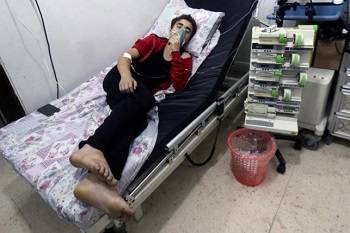At least four people died and many suffered breathing difficulties when a gas, believed to be chlorine, was dropped alongside barrel bombs on a neighborhood of the Syrian city of Aleppo on Wednesday, a hospital and a civil defense group told Reuters.
Hamza Khatib, the manager of Al Quds hospital in Aleppo, told a Reuters photographer the hospital had recorded four deaths from gas poisoning and 55 injuries. Seven people were still receiving hospital treatment.
Khatib said he was preserving pieces of patients clothing and fragments from the barrel bombs as evidence for analysis.
Syria Civil Defense, a Syrian rescue service operating in opposition-held territory, told Reuters it had recorded three deaths and 22 injuries after a barrel containing a gas suspected of being chlorine fell on the Zubdiya neighborhood of rebel-held Aleppo.
The group, which describes itself as a neutral band of search and rescue volunteers, said it could not independently verify the nature of the gas.
The Syrian Observatory for Human Rights, a war monitor, said helicopters dropped explosive barrels on the neighborhoods of Seif al Dawla and Zubdiya, leading to the death of a woman and her child from suffocation.
The northern city of Aleppo, Syria's most populous before the war, is split into opposition- and regime-held districts.
A fierce battle for control of the city broke out on Friday when opposition forces staged a major assault to break through a month-long regime siege of the city's opposition-held east, where about 250,000 people are thought to be living.
Fighters managed to pierce the ring of regime-controlled territory, but a safe corridor for civilians and aid has not yet been established.
There have been unconfirmed reports among activists and residents of chlorine gas falling on opposition-held east Aleppo since the offensive.
The Aleppo Media Centre, an online opposition news portal for the city, posted a video that it said was of victims of the gas attack: a child and adults wearing breathing apparatus. Two men interviewed said barrel bombs were dropped and there was a strong smell of gas. People then began to suffer breathing and eye problems.
Western powers say the regime has been responsible for chlorine and other chemical attacks.
U.N. investigators established that sarin gas was used in Eastern Ghouta in 2013. The United States accused Damascus of that attack, which it estimates killed 1,429 people, including at least 426 children.
Later that year the United Nations and the Syrian regime agreed to destroy the state's declared stockpile of chemical weapons, a process completed in January 2016.
The Organization for the Prohibition of Chemical Weapons confirmed in late 2015 that sulfur mustard, commonly known as mustard gas, had been used for the first time in the war.
PHOTO CAPTION
A civilian breathes through an oxygen mask at al-Quds hospital, after a hospital and a civil defense group said a gas, what they believed to be chlorine, was dropped alongside barrel bombs on a neighborhood of the Syrian city of Aleppo, Syria, early August 11, 2016.
Reuters


 Home
Home Discover Islam
Discover Islam Quran Recitations
Quran Recitations Lectures
Lectures
 Fatwa
Fatwa Articles
Articles Fiqh
Fiqh E-Books
E-Books Boys & Girls
Boys & Girls  Articles
Articles










